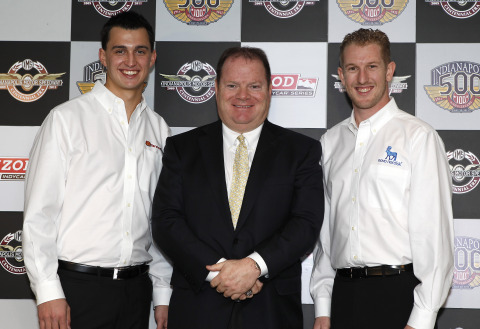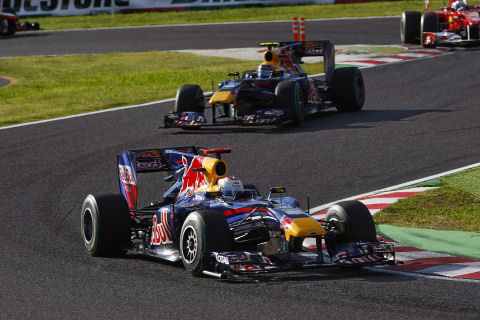The Way It Is/ Looking forward
by Gordon Kirby The final two months of last year witnessed the most powerful wave of good news for Indy car racing we've seen in many years. It started with Chevrolet's announcement in November that it will return to Indy car racing in 2012 as an engine supplier in partnership with Ilmor and an 'aero kit' builder too. A few days later Lotus also announced 2012 engine and 'aero kit' programs and in early December Roger Penske's team announced a slew of new sponsors as Shell/Pennzoil, IZOD, Meijer and Auto Club of America join Verizon with Team Penske's three-car operation.
The final two months of last year witnessed the most powerful wave of good news for Indy car racing we've seen in many years. It started with Chevrolet's announcement in November that it will return to Indy car racing in 2012 as an engine supplier in partnership with Ilmor and an 'aero kit' builder too. A few days later Lotus also announced 2012 engine and 'aero kit' programs and in early December Roger Penske's team announced a slew of new sponsors as Shell/Pennzoil, IZOD, Meijer and Auto Club of America join Verizon with Team Penske's three-car operation.
Penske's sponsorship blockbuster was followed by Panther Racing announcing that 2009 Indy Lights champion JR Hildebrand will drive Panther's National Guard car this year. Hildebrand, 23 on January 3rd, is a home-brewed talent who has shown his stuff in the lower formula. Hildebrand won the Formula Russell championship in 2004 and the FF2000 title in '06 before moving into Indy Lights. Replacing 2005 Indy 500 winner Dan Wheldon was a tough choice for John Barnes but he's made a good move with Hildebrand--good for the team, sponsor and the sport overall.
A few days later, just before Christmas, Chip Ganassi announced he's created a new two-car team for a pair of promising young Americans, Graham Rahal and Charlie Kimball. Service Central/NovoNordisk Chip Ganassi Racing will run Rahal and Kimball out of drag racer Don Prudhomme's shop in nearby Brownsburg. Ganassi's new team will operate at the races beside the existing championship-defending Target/CGR team with everyone sharing information so Rahal and Kimball should have every opportunity to run at or near the front.
Under Randy Bernard's energetic direction IndyCar has taken a positive turn over the past ten months and Ganassi says today's much healthier environment provided the backdrop for the creation of his new team.

© LAT USA
"Throughout 2010 we've been feeling the momentum that's been building in IndyCar racing and that momentum has been a big thing in bringing us to this point. All of us in the industry feel the momentum of what's going on in IndyCar racing right now. You can be as great a salesman as there is but if there's not real interest from people wanting to get involved in IndyCar racing your sales effort is going to fall short."
Ganassi emphasized the good news in new sponsors and home-brewed drivers coming into the IZOD IndyCar series for the 2011 season.
"We're going to have six American drivers next year, which is a big switch, and you're having some new sponsors come into the sport and some others that are getting bigger in the sport. That's a breath of fresh air for us on the team side when the interest level goes up. That's good for us and good for the sport."
Chip said he hired Rahal and Charlie Kimball because of their talent not because they're Americans.
"I think the key word is talented," Chip commented. "I've never been the most nationalistic guy when it came to having drivers in our cars. We always went for the talented guys first. I didn't care if they were from Italy or New Zealand or San Francisco. It could be any country. I think being talented is the starting point.
"But it just so happens that there's this surge of American drivers right now, guys who've been coming along and are ready to make the next step. These are obviously two of those guys and we're very proud to have them as part of our team and look forward to getting our arm around them as we go forward and helping them understand what our team is all about.

© Penske Racing
Meanwhile, Penske has leveraged every element of his thriving Penske Corporation's worldwide business to help sell his new range of sponsors. Penske's team president Tim Cindric admits that the Penske Corporation's global reach across many transportation-related businessses was a key component in forging the team's new sponsorship deals with Penske himself providing a superb deal-closing pitch as always.
"Without a doubt we've had to look at things more from an overall perspective rather than just a racing perspective," Cindric said. "I think the days of just having a billboard running around a racetrack are over. We've had to approach things from a leverage point of view, not only on the racetrack in terms of our competitiveness and what we have to offer at the racetrack. We've had to look at how we service our partnerships for business-to-business relationships.
"With the Penske world we're able to return numbers that show sales and new business and added value in addition to what the racing programs bring to the overall package. Roger has built his businesses based on his reputation in racing. When you look at his businesses they're all related to the transportation industry and we try to hone the art of putting sponsors together with each other to do business. That's a big part of it."
Despite Penske's and Ganassi's healthy additions IndyCar remains a tough sell for most teams. Newman/Haas, for example, is hoping Oriol Servia and James Hinchcliffe will find the personal sponsorships to keep the team in business while Paul Tracy has a partial sponsorship package but needs the Edmonton race to be revived to put his program together. Many other teams and drivers are in similar situations.
A major attraction to the 2011 IndyCar season are the celebrations surrounding the 100th anniversary of the Indianapolis 500. The first 500-mile at the Speedway took place in 1911, of course. This year's race will be the 95th running of the 500 with the 100th race taking place in 2016 and the centennary period will focus attention on both the Speedway and IndyCar racing, a perfect time for the sport's skein of new sponsors to help market and promote IndyCar racing in preparation for its relaunch with the new 2012 formula.
Of course, the most significant decision of the off-season was the FIA's agreement at the World Motor Sports Council meeting in November to adopt a 1.6 liter four cylinder turbo engine for F1 for 2013. KERS will be an integral part of the new power package and external wings will be reduced in size with more downforce coming from the underbody. Engine life will be extended further with the new formula. Each driver will be limited in 2013 to five engines (three fewer than currently) and four in 2014. Also, there will be a 12,000 rpm rev limit.

© LAT USA
Although not yet clarified, IndyCar's 2012 rules include a provision for a 1.6 turbo four-cylinder to run under an equivalency formula with the primary 2.4 liter V6 twin turbos. It's difficult to imagine how a small four-cylinder can be made competitive with a bigger V6, other than with inordinate amounts of boost, which wouldn't help reliability. Still, Randy Bernard is well aware of the coming arrival of the 'GRE' and has made room in the rules to encourage four cylinder turbo engines to enter IndyCar racing under the new 2012 formula.
So again, like it or not, the turbo four is just around the corner. It's all about downsizing and efficiency and following the path being taken by the global auto industry. FIA president Jean Todt is fully committed to the 'GRE' concept. Neither Ferrari nor Mercedes-Benz were fans of the move to the four-cylinder but he overruled F1's two most powerful brands to approve the new way. Todt is an old hand at the auto industry. He ran Peugeot's world rally and sports car teams before his successful stint as Ferrari's F1 team manager and it will be interesting to watch the 'GRE' trickle down through the rest of the sport under Todt's leadership over the next few years, although it's hard to imagine NASCAR making the switch. Over time, mind you, even NASCAR may have to make the move.
One question is what will these turbo four-bangers sound like? For sure, a good portion of motor racing's appeal comes from the aural aspect--the bark, whine or shriek of the exhaust note. Whether it's Formula One, NASCAR, drag racing, Moto GP or any other successful form of motor sport the sound of the engines holds considerable attraction. On the face of it a turbo four will sound flat, particularly with a 12,000 rpm rev limit and much less than that in most 'GRE' applications. So it will be critically interesting to hear the sound of the 2013 F1 engines.
The greatest example in racing history of a turbo four-cylinder was the venerable Offenhauser which raced from the thirties through the eighties. When the Offy's useful life as a normally-aspirated engine came to an end in the sixties it was revived by turbocharging. During the seventies and eighties the Offy saw massive boost pressure, well over 100 inches for qualifying before boost limits were brought in, first at 80 inches, then lower and lower.
The turbo Offy was 2.6 liters, of course, and sounded like a bomb ready to go off. The new 1.6 liter 'GRE' will not only be much smaller in swept volume but will also run much less boost so the sound is sure to be very different. Are you ready for it?
Auto Racing ~ Gordon Kirby
Copyright 2011 ~ All Rights Reserved
Copyright 2011 ~ All Rights Reserved
Top of Page